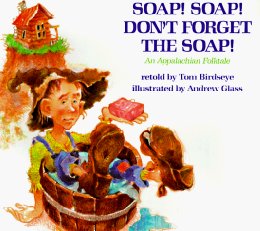 We loved and laughed and quoted this book since our chiblin’ were mere toddlers. (You should probably be forewarned that this post is much longer than that book and not nearly as entertaining.)
We loved and laughed and quoted this book since our chiblin’ were mere toddlers. (You should probably be forewarned that this post is much longer than that book and not nearly as entertaining.)
This is one of those DIY projects that just makes my life a little sweeter. A simple thing that spoils me happy. Not a one of us forget the soap now. Even my children asked to take a bar of this with to camp. As if I’m going to say no.
Wait. A. Minute.
The joke’s on me since it never comes out of their bag once there, does it?
Don’t answer that. Ignorance is bliss.
Well, never mind that now.
What’s important is that a good homemade soap has a high silky lather, is super creamy and extra moisturizing. It softens the skin and most can be used as shampoo. That’s good enough for me, but there is that Goats Milk thing on top of it. The Benefits of Goats Milk include more than 50 nutrients, minerals, acids and enzymes that help nourish and revitalize dehydrated skin. Using it regularly skin will be prone to less liver spots, lines, wrinkles…and it can relieve symptoms of eczema, psoriasis, acne and even help with poison ivy. It just has elements in it that no other milk does.
I am telling you…Goats Rock.
Yes even you Moonie. (She was our first LaMancha, gobbling spring grass before her first summer haircut in this picture.)
The difference between this soap and commercial soap is so vast that I am afraid there is no going back for me now. (And here I thought we wanted dairy goats just for cheese.) Even though there are Dove soap bars under the sink still—left over since last summer I might add, when we are down to just a few bars of the goats milk soap, life as we know it is put on hold, out come the soap making supplies, and the commercial brand stays in the dark, unused.
Unfortunately I am not EVEN close to being an expert at this soap making thing at all. Actually I am not an expert at anything which is a great disappointment at my age, but I like to pretend I know enough to share when I get excited about something. And did I mention how much I love this soap?
To date I have just made half a dozen batches of soap using an equal number of recipes, which I realize is still the beginner stage, and I really want to start experimenting more, but I want you to know…
10 things from what I have learned so far –from all the questions I wanted answered, in case it’s helpful:
1. Yes you do need lye to make soap. No lye? —Only a puddle of oils then.
Ancient cultures found that after cooking meat on the fire, the fat drippings in the ash, mixed with water splashed on to put the dire out, made soap. So yes you can make lye with your own ashes, but that’s a whole ‘nother project! For now I just go to a hardware store to buy my lye. (plumbing section.)
2. Protection from the lye while making soap is also a good idea. Goggles over glasses and surgical masks over nose and mouth don’t go well together. Fog issues. Ya, that was a bit overkill not to mention quite the sight I’m sure. Then add rubber gloves and you pretty much feel incapable of doing anything…but it does work, and okay, apparently I was a bit paranoid about getting burned by that lye, however I quickly nixed the surgical mask and stayed with just my own glasses and chose thin latex gloves.
3. Vinegar. Along with warm soapy water, neutralizes any remnants of lye in case of an accidental splash or just to clean equipment if you wish to use it for other than soap making. (Still hesitant myself on that though). A jug sits next to my creating station.
4. Tallow is fat rendered from Beef, Lard is fat rendered from Swine. I never knew that it was species specific. Hmm. Both have been the backbone of soap making for centuries. (If you are butchering and not rendering the fat yourself, could I try some please?!) and Soybean oil is…Crisco. Shortening. And since soybeans are pretty much all GMO’s here in America, I am avoiding that in my body even via my skin. I’m sure you think I’m crazy, and…you’re are probably right.
5. Two very important measurement tools: a good digital scale is my friend. So is this lye calculator at MMS.
6. What and Where Ingredients: I have been using beautiful thick butters like shea, cocoa, mango, avocado, as well as healthy oils from coconut to sweet almond, grapeseed, jojoba and olive. After I read about delightful qualities in something I want to try adding it in. These ingredients make the soap so rich they are really shampoo bars. It really is all I take with when traveling, for my shampoo, face and body. One soap bar. (More space in that 1-quart ziplock baggy when going through airport security I tell ya)
I have purchased some of these items from the grocery store or Costco (olive, grapeseed, coconut oils) others online; theSage.com, or try NewDirectionsAromatics.com.
7. Soap making in a nutshell: The oils and butters are melted together, and separately the liquid and lye are mixed together. Then the two mixtures are combined and emulsified–blended together until it thickens, turning into soap.
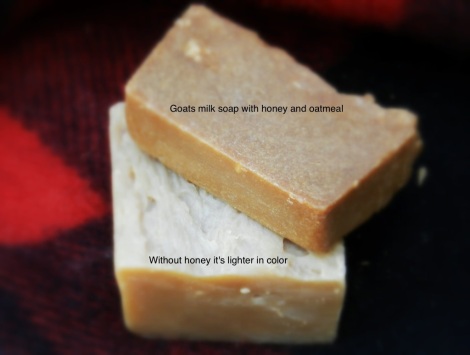
8. The cooler temperature you keep the milk, the lighter the soap color. Honey makes it smell wonderful and adds more healing properties, but it also makes the soap much darker in color, even if you kept your soap cool and a light color up to the point of adding the honey. (It freaked me out the first time I added it, I wasn’t warned. You now are.)
9. Immersion blender is key to saving time. Minutes vs. hours I hear. Try garage sales or a thrift store.
10. Hot Process vs. Cold Process simplified:
Cold process takes half the time to make, but waiting 6 weeks for it to cure (smoother soap results),
Hot process is cooking it one more hour to be able to use it right away (more of a rough/rustic looking soap).
Even though I love the smooth results of cold process soap, I choose hot process…made in an old crock pot, so I can not only make it outside due to the lye fumes, but then I can use the soap that same day if need be.
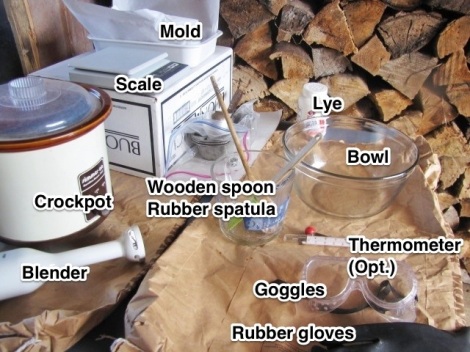
Equipment supplies are minimal, mostly garage sale finds:
crockpot, blender, bowls, wooden spoon, rubber spatula…I have a thermometer for soap making, but have yet to use it.
Shoe boxes make good molds, safety equipment for yourself and again, a digital scale is necessary.
Ingredients can be as simple as coconut oil (that’s the lather part), olive oil (that’s the moisturizing part), liquid —goats milk in this case (the moisturizing nourishment for skin), and lye, or as many oils and butters that you want to add for their individual benefits. When I was reminded that our skin is the largest organ in our body, I was excited about adding all these wonderful things in my own soap. If you are like me, the more you read about them, the more you will want to use ingredients in your soap that you can actually pronounce.
Recipes
It was a great “light bulb moment”, realizing that you can twink (spell check doesn’t like that word) a soap recipe or even make your own, as long as you have two things: a scale, since soap making goes by weights not amounts, AND access a lye calculator to figure your fats and give you an accurate lye ratio and liquid amount to use. My personality needs that freedom.
A simplified recipe may look like this:
GOATS MILK SOAP
•21 oz. Olive oil
•9 ounces Coconut oil
•4.1-4.2oz. Lye
•9 oz. goat milk frozen in ice cube sized chunks. (Water or other milks can be used)
Or something with more dimension to it could be:
LUXURIOUS GOATS MILK SOAP/SHAMPOO BAR
-9 ounces coconut oil
-9 ounces olive oil
-5 ounces castor oil
-3 ounces jojoba oil
-2 ounces shea butter
-2 ounces cocoa butter
-1 ounce beeswax
-12 ounces goats milk frozen, slightly slushy
-4.1-4.5 ounces lye
Substitutions have been made on every soap recipe I have tried since it has to do with what ingredients are stocked in this house…it then gets run through the lye calculator to avoid messing up with the lye amounts. So the next time I made the above recipe I really wanted to add honey, make a bigger batch, and was low on jojoba oil. It changed quite a bit… to this:
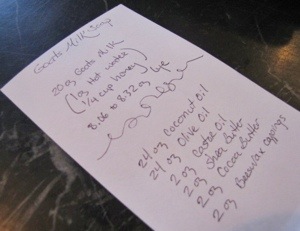
Which also gave a beautiful bar, softer, darker and sweet smelling.
This last weeks batch I was out of olive oil so I used grapeseed, coconut and palm oils, three different butters and no beeswax or other additions.
The bottom line is we are not confined to a specific recipe, feel free to experiment. (But use a lye calculator!)
Steps
The first step is careful measuring of the oils and butters, melt together in a pot and allow to cool slightly.
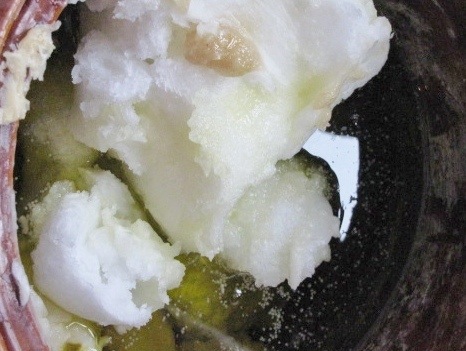
This was taken during one of my very first batches. (The little white specks are stearic acid, which I had from lotion making. It is a thickener as is beeswax, which I also used in one soap recipe. Neither are necessary to soap making, I was just trying out different recipes and ingredients.)
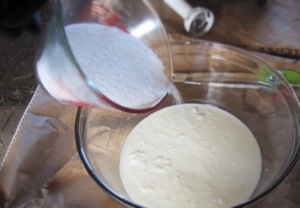
Goats milk needs to be frozen; cubes or slushy to start with. The lye heats up the icy goats milk quickly and could burn the milk otherwise. This makes the soap darker and gives it an unpleasant smell. Not as bad as breathing the lye fumes, but…
IF one adds just a couple tablespoons of lye at a time, keeping the bowl on ice (or in the winter, I kept in the snow…much more convenient) you can keep the temperature under 100 degrees to keep the soap from burning the milk. I simply go by the color vs. a thermometer. If it starts to get the least bit “orange” I stir until it’s cooled before adding more lye.
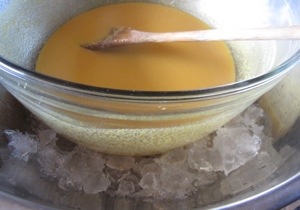
The lye is gradually added to the liquid. (Not the other way around) Not something I could not accomplish and hold a camera at the same time, so just imagine that part.
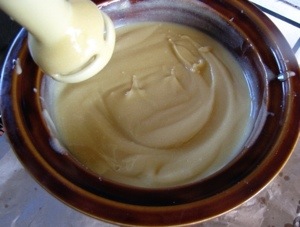
This is how happy I was that I got my first batch to ‘trace’ or thicken, so quickly.
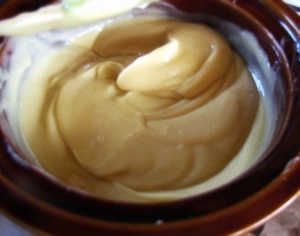
…just a little thicker though. Like pudding. Then any additives such as ground oatmeal, fragrance or essential oils, could be stirred in. I’ve been keeping ours fragrance free, just enjoying natural scents like the cocoa butter or honey if added, but that may change as I experiment more.

You can see how smooth it is. At this point I could pour it into molds as a cold processed soap, and it would need to be covered with thick towels or a blanket to keep it warm as it slowly hardens.
After the soap hardens in the molds, remove it and cut into the size bars you desire. Let it continue to dry on a rack for 6 weeks, turn several times during those weeks. This is necessary for the excess moisture to evaporate and the lye to neutralize…both go together.
When made properly, there is no lye or sodium hydroxide left in a finished bar of soap. The process of saponification (lye into soap) changes the lye and oil into soap and glycerin, with a pH of approx 8.5 to 10 when fully cured. That’s where the 6 weeks come into play.
You can speed this process up by getting the lye neutralized, or the saponification completed by cooking it. I love this step because I can not WAIT!
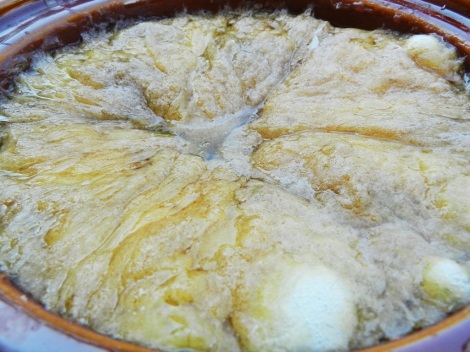
This can be done in the crockpot for about an hour on LOW, until it bubbles and the nourishing glycerin begins to puddle on top.
Continue cooking (still on low). I stir occasionally.
When glycerin is reincorporated in the soap, it actually attracts water out of the air causing it to have unparalleled moisturizing ability and therefore be extremely beneficial to the skin. This is removed from commercial soaps.
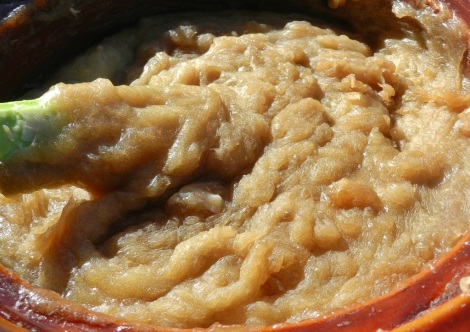
The dry mashed potato look is what we’re looking for.
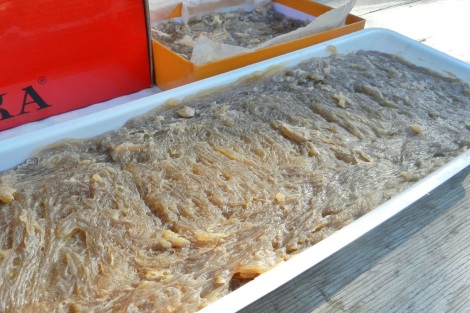
Then it’s time to pour into your molds. This time I used a drawer organizer from Ikea, and a small cardboard box lined with parchment. Both greased with coconut oil. Pour quickly, as it begins to harden right away.

Within an hour they were dry enough to pop out of the molds and cut into bars. It’s like butter at this stage.

I really am drawn to the textured artesian look of this soap.
Even though these bars are usable directly, I still let the remainder bars air dry to harden more…a day or two, before I store them in a breathable cardboard shoe box. Well, the word “store” in that sentence is rather ambiguous since we use them up so quickly.
This picture shows just a tiny part of reality at our home. Projects everywhere. But yes the soap leaves the kitchen soon after hitting the drying rack… mainly because we must move our projects off the table so we can EAT. (I take back that ‘not an expert’ thing…I am pretty good at moving piles around, expert at that in fact.)
If you want to try making your own soap, gathering the supplies and equipment is going to be the biggest thing. Once that is accomplished the actual soap making takes about 2 hours for Hot Processed Soap, from measuring to molds. Not bad considering the end result! There are dozens of tutorials on soapmaking on the web to give you more recipes, details, photographs and scientific answers to your questions by those that know more than I. My goal is simply to whet your appetite to either try some goats milk soap out, or even encourage you to give soap making a shot…because you CAN and it’s worth it! Then you will be chanting “Soap, soap, I could never forget my homemade soap.”

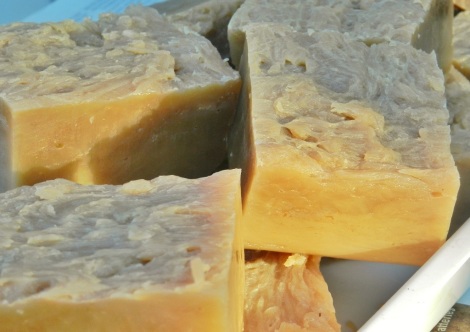
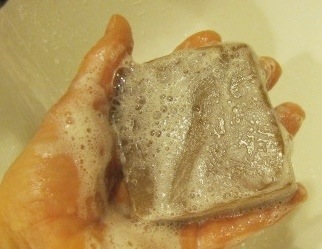
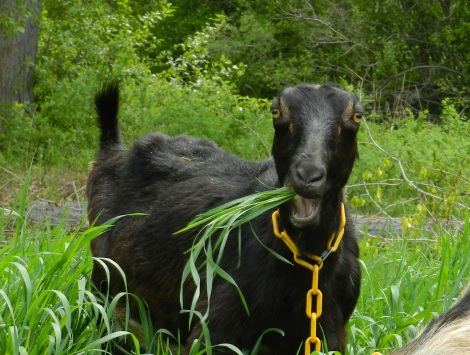
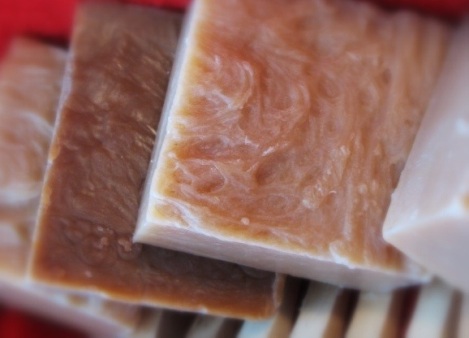
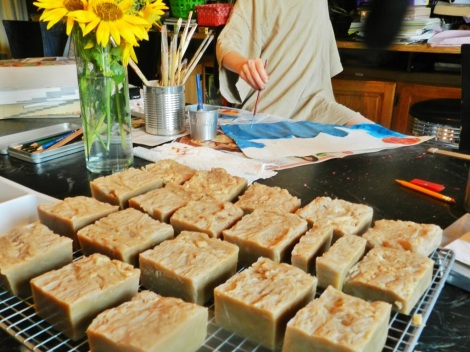
Thank you for this wealth of info! I can’t wait to try it out. Our Nanny goat should be ready to start milking by the end of this month. Oh, the possibilities 🙂
Thank you for sharing a sample of your wonderful Goats Milk Soap with me. Still have some left.
This will be my first time making Goats Milk Soap! I want to Thank You for this valuable information! I have been seen lots of videos and web sites looking for information, but I had lots of doubts about the steps to follow, Your way to explained the process is clear and very informative and now I feel confident to proceed and start making soaps. Once again Thank You! 🙂
Yay! First that I made any sense to someone else (for that I thank you), and second that you are going to do it! Good for you Carol.
Could you give a guess on how many lbs this makes? I want to try it this weekend 🙂
I have never weighed results, I need to do that! I have read that end result weight is about the same as the amount of your oils plus water or goats milk in this case. Hope that helps?
I’m trying to find a way to email you, but I can’t. I’m so happy I found your blog! I can’t find anyone to help me with my question. I am making soap for the first time. The ingredients I have on hand are refined coconut oil, beeswax, shea butter, cocoa butter, and goat’s milk. I know I need the lye. However, I don’t know what else I need to add! I do not know how much of what to add! I don’t need to necessarily use all the ingredients that I have, but if you could help me with a recipe including some of the thing I do have and some things I could probably just grab at my local store, that would be great! Oh, I have raw honey too 😉 I plan in grinding up some oatmeal and adding that in also, and maybe an essential oil with a fall scent. Cinnamon and clove maybe? All natural of course 🙂 Would love a response. Dying to get started 🙂 Thanks!
Jenni…I’m excited FOR you! I am not an expert but I love to share my two bits! I would suggest just adding olive oil to your ingredients. I love love love coconut oil and the lather it gives, I have read to try to keep it under 20% of the oils/butters or it will be too drying. (I do not always follow that rule though, and have not noticed any obvious difference.) You don’t really need the beeswax, but it can’t hurt…i’ve used it a bit too. So I took your ingredients and went to the MMS lye calculater: https://www.thesage.com/calcs/LyeCalc.html and just guessed at what amounts you may have and came up with this:
24oz olive oil, 10 oz coconut oil, 6 oz cocoa butter, 6 oz shea butter, 2 oz beeswax, 12-18 oz goats milk and between 6.27-6.47oz lye.
Feel free to up the coconut oil yourself on the lye calculator and it will give you the updated goats milk and lye amounts.
With all those butters this will definitely be a rich creamy luxurious soap. The honey is also a wonderful addition, it will turn your soap a darker brown, and you won’t need much oatmeal…start with about 4 tablespoons of both of those? Rule of thumb on e.o. is about 2-3 oz per pound of soap. Ya, I know, it get’s pricy. You could even add ground cinnamon too. Have fun!
Thanks so much! I’m so clueless on how much oils you need compared to fats, ect. So, these calculators do me no good, at this point anyway! This is more confusing starting out than I thought it would be! I don’t need to use every ingredient that I have. I just wanted to let you know what I already had. Do you think that I could not use up all my ingredients I have, and still make a nice soap? That way, maybe I have enough ingredients to try out a couple batches of soap? 🙂 I’d rather not use my good EO’s for soap. Maybe add cinnamon and possibly clove to get a nice sent for fall, or will the scent just evaporate right out if I use a food supply instead of an EO? I only have 12 oz. of cocoa and shea butter, and you know those aren’t cheap. So, if I could cut down the recipe on those and sub. with more of something else, that would be great! What about tallow, lard, palm oil(shortening) have you tried any of these yet? Just curious. Seems there is so many recipes out there! I’m so confused! LOL
Yes I have used tallow…it makes a much harder soap that lasts longer and was so nice to have. (which reminds me to finish a post on making tallow!) Definitely use it if you have some! You can use a huge part of your recipe as tallow or lard.
Most soap recipes don’t even include butters…perhaps because of the cost? As for ratios, there is nothing set in stone that I have found. Everyone has their own ideas. I’ve seen some soap makers give a ratio of 33%/33%/33% using 3 different oils or 30%/30%/30%/10%…using that last 10% for some special oil or butters. And then there is Castile soap which can be all olive oil with the lye and water. Not sure if that helps you.
So of course you can cut down your butters and other ingredients for more batches in the future…how about starting with 2 oz each even, just that amount is a great addition.
Yes coming up with a recipe with what ingredients I have on hand sometimes seems to take more time than I anticipate. But as long as your creativity is run through the lye calculator you’ll be fine with whatever you choose to use!
I hear your pain on the cost of EO in soap. I just can’t do it myself! Well, I did once, and it WAS nice. So yes, I would experiment with foods…cinnamon and cloves would be awesome.
Anxious to hear what you end up with!
I’m so freaked out! I’m going to finally try it this weekend! Yikes! If I use less shea and cocoa butter(2oz.), what should I substitute more of?
“lye neutralized, or the saponification completed by cooking it” When is this step done?
Thanks for pointing out that confusing sentence! My very unscientific understanding of the process is that the saponification is when the fat/oils/liquid and the lye have made soap. So: after it comes to a trace (thickens), that part—the saponification, would be completed. By cooking it further (hot process) one speeds up neutralizing the lye, and that usually takes about another hour of cooking to complete that (neutralizing lye) process. I use the old if-it-zings-my-tongue-it’s-not-done method.
Hi,
Thanks for the great recipe. I am trying this today with powdered milk. I didn’t quite see the place of hot water in your recipe especially if the lye will heat up anyway.
Please advise, I’m new to HP.
I would not use hot water, you are correct that the lye will heat it up anyway…use cold to mix your powdered milk. I have not read anything about benefits of powdered milk, so check that out first, otherwise you can just use water.
And, I have lots of tallow and Shea butter, where can I substitute these in the recipe?
I plan to be at a garden/garage sale this weekend so I want to make lots of soap ready by then.
Thanks:-)
Of course! The tallow makes the bars much harder, so they last longer, and the Shea butter makes it so very moisturizing…it’s a wonderful addition to soap. You will still need to add a liquid oil like olive oil, I would try having the largest amount of tallow, half of that of olive oil, and a small of of Shea butter (3-4 oz?) Whatever you use, be SURE to to run your amounts through a lye calculator (online) to verify you amounts of both lye and liquid. Have fun!
Love the recipe! What percentage of superfat do you use on the shampoo bar?
Was it the shampoo bar recipe you liked? Honestly I have never “superfatted” (that I know of) any soap recipe since that’s a new concept for me! I researched multiple shampoo bar recipes, took what I liked from several, used or substituted what I had on hand, and ran it through the lye calculator, using the lower amount of the lye range given.
I love your recipes for goat milk soap !!! Since soap making in the process of becoming soap, does that negate the goat milk and change it the properties of the goat milk soap?
Hi Jan! I can only tell you that I have read and heard (books and classes) that the goats milk has very nourishing properties in soap, and so I accept that. I honestly don’t know how to test that myself —other than I don’t think I can ever go back to regular soap!